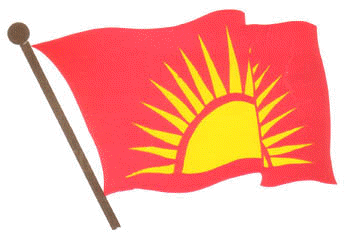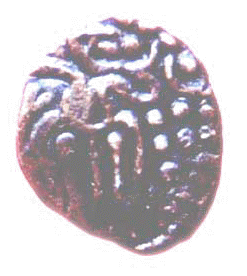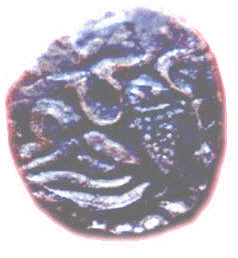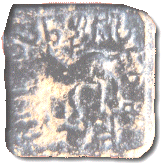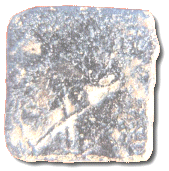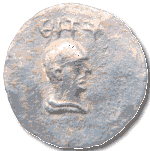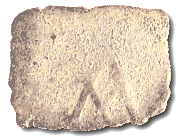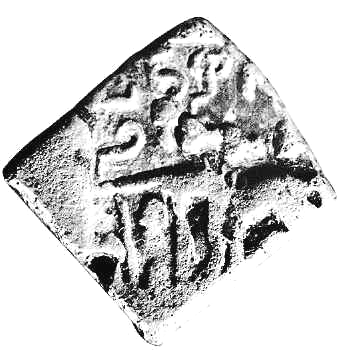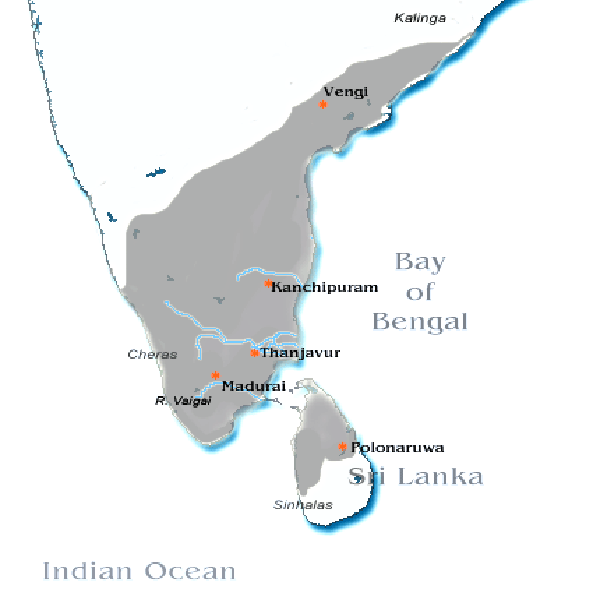|
|
The Pandyan kingdom was an ancient Tamil state in South India of unknown antiquity. Pandyas were one of the three ancient Tamil kingdoms (Chola and Chera being the other two) who ruled the Tamil country from pre-historic times until end of the 15th century. They ruled initially from Korkai, a sea port on the southern most tip of the Indian peninsula, and in later times moved to Madurai.
Pandyas are mentioned in Sangam Literature (c. 100 - 200 CE) as well as by Greek and Roman sources during this period. Pandya ("Panyue 盤越 also called Hanyue wang 漢越王") is also apparently referred to in the 3rd century Chinese History, the Weil�e.[1]
The early Pandyan dynasty of the Sangam literature went into obscurity during the invasion of the Kalabhras. The dynasty revived under Kadungon in the early 6th century, pushed the Kalabhras out of the Tamil country and ruled from Madurai. They again went into decline with the rise of the Cholas in the 9th century and were in constant conflict with them. Pandyas allied themselves with the Sinhalese and the Cheras in harassing the Chola empire until they found an opportunity for reviving their fortunes during the late 13th century.
Pandyas entered their golden age under Jatavarman Sundara Pandyan (c. 1251) who expanded their empire into Telugu country and invaded Sri Lanka to conquer the northern half of the island. They also had extensive trade links with the Southeast Asian maritime empires of Srivijaya and their successors. During their history Pandyas were repeatedly in conflict with the Pallavas, Cholas, Hoysalas and finally the Muslim invaders from the Delhi Sultanate. The Pandyan Kingdom finally became extinct after the establishment of the Madurai Sultanate in the 16th century.
The Pandyas excelled in both trade and literature. They controlled the pearl fisheries along the south Indian coast, between Sri Lanka and India, which produced one of the finest pearls known in the ancient world. Tradition holds that the legendary Sangam were held in Madurai under their patronage. Some of the Pandya kings were Sangam poets .
Religiously the ancient Pandyas were Jains with a strong influence of the Dravidian religeon. Aruhakkadavul was the major God. The later day Pandyas after 600 AD were Hindus who proudly claimed to descend from Lord Shiva and Goddess Parvati.Pandiyan Nedumchadayan became a staunch Vaishnavite.[2]
Various Pandya kings find mention in a number of poems in the Sangam Literature. Among them Nedunjeliyan, 'the victor of Talaiyalanganam', and Mudukudimi Peruvaludi 'of several sacrifices' deserve special mention. Besides several short poems found in the Akananuru and the Purananuru collections, there are two major works - Mathuraikkanci and the Netunalvatai (in the collection of Pattupattu) give a glimpse into the society and commercial activities in the Pandyan kingdom during the Sangam age.
It is difficult to estimate the exact date of these Sangam age Pandyas. The period covered by the extant literature of the Sangam is unfortunately not easy to determine with any measure of certainty. Except the longer epics Silapathikaram and Manimekalai, which by common consent belong to the age later than the Sangam age, the poems have reached us in the forms of systematic anthologies. Each individual poem has generally attached to it a colophon on the authorship and subject matter of the poem, the name of the king or chieftain to whom the poem relates and the occasion which called forth the eulogy are also found.
It is from these colophons and rarely from the texts of the poems themselves, that we gather the names of many kings and chieftains and the poets and poetesses patronized by them. The task of reducing these names to an ordered scheme in which the different generations of contemporaries can be marked off one another has not been easy. To add to the confusions, some historians have even denounced these colophons as later additions and untrustworthy as historical documents.
Any attempt at extracting a systematic chronology from these poems should take into consideration the casual nature of these poems and the wide differences between the purposes of the anthologist who collected these poems and the historian�s attempts to arrive at a continuous history.
The earliest Pandya to be found in epigraph, is Nedunjeliyan figuring in the Minakshipuram record assigned from the second to the first centuries BCE. The record documents a gift of rock-cut beds, to a Jain ascetic. Punch marked coins in the Pandya country dating from around the same time have also been found.
Pandyas are also mentioned in the Pillars of Ashoka (inscribed 273 - 232 BCE). Asoka in his inscriptions refers to the peoples of south India as the Cholas, Cheras, Pandyas and Satiyaputras as recipients of his Buddhist proselytism. These kingdoms, although not part of the Mauryan Empire, were in friendly terms with Asoka:
- "The conquest by Dharma has been won here, on the borders, and even six hundred yojanas (5,400�9,600 km) away, where the Greek king Antiochos rules, beyond there where the four kings named Ptolemy, Antigonos, Magas and Alexander rule, likewise in the south among the Cholas, the Pandyas, and as far as Tamraparni (Sri Lanka)." (Edicts of Ashoka, 13th Rock Edict, S. Dhammika).
The Periplus of the Erythraean Sea (c. 60 - 100 CE) describes the riches of a 'Pandian Kingdom':
- ...Nelcynda is distant from Muziris by river and sea about five hundred stadia, and is of another Kingdom, the Pandian. This place also is situated on a river, about one hundred and twenty stadia from the sea.... [3]
The Chinese historian Yu Huan in his 3rd century text, the Weil�e, mentions a The Kingdom of Panyue:
- "...The kingdom of Panyue is also called Hanyuewang. It is several thousand li to the southeast of Tianzhu (Northern India)...The inhabitants are small; they are the same height as the Chinese..."[4]
The Roman emperor Julian received an embassy from a Pandya about 361. A Roman trading centre was located on the Pandyan coast (Alagankulam - at the mouth of the Vaigai river, southeast of Madurai).
Pandyas also had trade contacts with Ptolemaic Egypt and, through Egypt, with Rome by the first century, and with China by the 3rd century. The 1st century Greek historian Nicolaus of Damascus met, at Damascus, the ambassador sent by an Indian King "named Pandion or, according to others, Porus" to Caesar Augustus around 13 CE (Strabo XV.1-4, and Strabo XV.1-73).[5]
Although there are many instances of the Pandya kingdom being referred in ancient literature and texts, we currently have no way of determining a cogent genealogy of these ancient kings. In order to maintain verifiability of this article, the names of these early Pandya Kings have been omitted. We have a connected history of the Pandyas from the fall of Kalabhras during the middle of the 6th century.
The following lists of the Pandya kings are based on the authoritative A History of South India from the Early Times to the Fall of Vijayanagar by K.A.N. Sastri, OUP, New Delhi (Reprinted 1998).
The following is a partial list of Pandyan emperors who ruled during the Sangam age:[6][7][8]
- Nedunj Cheliyan I ( Aariyap Padai Kadantha Nedunj Cheliyan )
- Pudappandiyan
- Nedunj Cheliyan II ( Pasumpun Pandiyan)
- Mudukudumi Paruvaludhi
- Nedunj Cheliyan III ( Talaiyaalanganathu Seruvendra Nedunj Cheliyan )
- Nan Maran
- Maran Valudi
- Musiri Mutriya Cheliyan
- Ukkirap Peruvaludi
First Empire
After the close of the Sangam age, the first Pandyan empire was established by Kadungon in the 6th century defeating the Kalabhras. The following is a chronological list of the Pandya emperors is based on an inscription found on the Vaigai riverbeds.
- Kadungon 560 - 590
- Maravarman Avani Culamani 590 - 620
- Cezhiyan Cendan 620 - 640
- Arikesari Maravarman Nindraseer Nedumaaran 640 - 674
- Kochadaiyan Ranadhiran 675 - 730
- Arikesari Parankusa Maravarman Rajasinga 730 - 765
- Parantaka Nedunjadaiyan 765 - 790
- Rasasingan II 790 - 800
- Varagunan I 800 - 830
- Sirmara Srivallabha 830 - 862
- Varaguna II 862 - 880
- Parantaka Viranarayana 862 - 905
- Rajasimha III 905 - 920
After the defeat of the Kalabhras, the Pandya kingdom grew steadily in power and territory. With the Cholas in obscurity, the Tamil country was divided between the Pallavas and the Pandyas, the river Kaveri being the frontier between them.
After Vijayalaya Chola conquered Thanjavur defeating the Muttarayar chieftains around 850, the Pandyas went into a period of decline. They were constantly harassing their Chola overlords occupying their territories. Parantaka Chola I invaded the Pandya territories and defeated Rajasinha III. However Pandyas reversed this defeat to gain back most of their lost territories.
The Chola domination of the Tamil country began in earnest during the reign of Parantaka Chola II. Chola armies led by Aditya Karikala, son of Parantaka Chola II defeated Vira Pandya in battle. The Pandyas were assisted by the Sinhalese forces of Mahinda IV. Pandyas were driven out of their territories and had to seek refuge in the island of Sri Lanka. This was the start of the long exile of the Pandyas. They were replaced by a series of Chola viceroys with the title Chola Pandyas who ruled from Madurai from c. 1020.
The following list gives the names of the Pandya kings who were active during the 10th and the first half of 11th century. It is difficult to give their date of accession and duration of their rule. Nevertheless their presence in the southern country require recognition.
- Sundara Pandya I
- Vira Pandya I
- Vira Pandya II
- Amarabhujanga Tivrakopa
- Jatavarman Sundara Chola Pandya
- Maravarman Vikrama Chola Pandya
- Maravarman Parakrama Chola Pandya
- Jatavarman Chola Pandya
- Srivallabha Manakulachala (1101 - 1124)
- Maaravaramban Seervallaban (1132 - 1161)
- Parakrama Pandiyan (1161 - 1162)
- Kulasekara Pandyan III
- Vira Pandyan III
- Jatavarman Srivallaban (1175 - 1180)
- Jatavarman Kulasekara Devan (1180 - 1216)
The 13th century is the greatest period in the history of the Pandyan Empire. Their power reached its zenith under Jatavarman Sundara Pandyan in the middle of the 13th century. The foundation for such a great empire was laid by Maravarman Sundara Pandya early in the 13th century.
- Maravarman Sundara Pandya (1216 - 1238)
- Sundaravaramban Kulasekaran II (1238 - 1240)
- Maaravaramban Sundara Pandiyan II (1241 - 1251)
- Jatavarman Sundara Pandyan (1251 - 1268)
- Maaravaramban Kulasekara Pandyan I (1268 - 1308)
- Sundara Pandyan IV (1309 - 1327)
- Vira Pandyan IV (1309 - 1345)
The Pandyan kingdom was replaced by the Chola princes who assumed the title as Chola Pandiyas in the l1th century. After being overshadowed by the Pallavas and Cholas for centuries, Pandyan glory was briefly revived by the much celebrated Jatavarman Sundara Pandyan in 1251 and the Pandya power extended from the Telugu countries on banks of the Godavari river to the northern half of Sri Lanka. This success had a lot to do with the rapid decline of the Great Imperial Cholas and also to the extraordinarily brilliant revival attempts made by the later pallava chiefs Kopperunjinga I and Kopperunjinga II, who in their brief tenure were very successful against the Hoysalas who were rising to power.
The Pandyan kingdom was only a default successor to the void created by complete extinction of illustrious Cholas and Pallavas. Marco Polo notes that the Pandyan kingdom though the richest in the world, and very prosperous did not possess the proportionate military strength. Many chiefs keeping up the trend of that age all over the world, were not only corrupt and irresponsible but also displayed their evil tendencies when they allowed and supported the revival of obscure and occult practices (like black magic and manipulation) that had stayed strictly banned since early pallava period.
On the death of Maravarman Kulasekara Pandyan I in 1308, a conflict stemming from succession disputes arose amongst his sons. Sundara Pandya and Vira Pandya fought each other for the throne. Soon Madurai fell into the hands of the invading armies of the Delhi Sultanate who were making the most of corruption and anarchy in the subcontinent. Pandyas and their descendants were confined to a small region around Thirunelveli for a few more years and after the 17th century C.E. we hear no more of them.
After Madurai fell into the hands of the invading armies of the Delhi Sultanate, the Pandyas sought the help of Vijayanagar Empire. The Vijayanagar Empire replaced the Delhi Sultanate in Madurai and appointed Nayak governors to rule from Madurai.
- ^ [1] Draft Translation of the Weil�e by John Hill
- ^ Major World Religions: From Their Origins to the Present, by Lloyd V. J. Ridgeon.
- ^ Periplus 54. Original Greek: "Ἡ δὲ Νέλκυνδα σταδίους μὲν ἀπὸ Μουζιρέως ἀπέχει σχεδὸν πεντακοσίους, ὁμοίως διά τε ποταμοῦ (καὶ πεζῇ) καὶ διὰ θαλάσσης, βασιλείας δέ ἐστιν ἑτέρας, τῆς Πανδίονος� κεῖται δὲ καὶ αὐτὴ παρὰ ποταμὸν, ὡσεὶ ἀπὸ σταδίων ἑκατὸν εἴκοσι τῆς θαλάσσης."
- ^ [2] Draft Translation of the Weil�e by John Hill
- ^ Strabo XV.1
- ^ Husaini, A.Q. (1972). History of The Pandya Country, pp. 8-17.
- ^ Sastri, Nilakanta K.A. (1966). "The Pandyan Kingdom", pp 22-25.
- ^ Purushottam, Vi. Pi. (1989). Cankakala Mannar Kalanilai Varalaru, pp 42.
- Carswell, John. 1991. "The Port of Mantai, Sri Lanka." RAI, pp. 197-203.
- Hill, John E. 2004. The Peoples of the West from the Weil�e 魏略 by Yu Huan 魚豢: A Third Century Chinese Account Composed between 239 and 265 CE. Draft annotated English translation. [3]
- Nagaswamy, R. Tamil Coins - a study (1981)
- Ray, Himanshu Prabha, ed. 1996. Tradition and Archaeology: Early Maritime Contacts in the Indian Ocean. Proceedings of the International Seminar Techno-Archaeological Perspectives of Seafaring in the Indian Ocean 4th cent. B.C. � 15th cent. A.D. New Delhi, February 28 � March 4, 1994. New Delhi, and Jean-Fran�ois SALLES, Lyon. First published 1996. Reprinted 1998. Manohar Publishers & Distributors, New Delhi.
- Reddy, P. Krishna Mohan. 2001. "Maritime Trade of Early South India: New Archaeological Evidences from Motupalli, Andhra Pradesh." East and West Vol. 51 � Nos. 1-2 (June 2001), pp. 143-156.
- Shaffer, Lynda Norene. 1996. Maritime Southeast Asia to 1500. Armonk, New York, M.E. Sharpe, Inc.
[The text of this article from Wikepedia is published here under the terms of the GNU Free Documentation License.]
